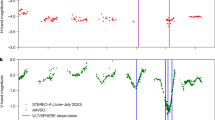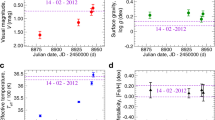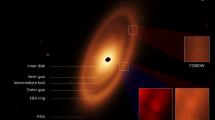Abstract
ABOUT thirty-five years ago Sir Norman Lockyer held that certain of the reddish stars are probably in an early stage of development. It was given out yesterday in Press dispatches from Chicago that Prof. Michelson had announced to the American Physical Society and the American Association for the Advancement of Science that the experiments with the Mount Wilson 8-ft. reflector at Pasadena, California, had enabled him successfully to measure the diameter of α Orionis by interference methods, and that the diameter is about 300,000,000 miles, or approximately three hundred times that of our sun. The volume of Betelgeux is therefore about 27,000,000 times that of the sun; so that, if concentric with the sun, the surface of Betelgeux would extend about to the orbit of Venus.
This is a preview of subscription content, access via your institution
Access options
Similar content being viewed by others
Change history
01 January 1921
—Dr. T. J. J. See sends the following corrections of values given by him in his letter on the measurement of the angular diameter of Betel-geux printed in last week's issue of NATURE, p. 663:— Lines 16 and 24, “orbit of Venus” should be “orbit of Mars.” Lines 33–35 should read: “Sirius, which is itself twenty-fivefold more luminous than our sun. Accordingly, Betelgeux gives about 6500 times the sun's light.”
Author information
Authors and Affiliations
Rights and permissions
About this article
Cite this article
SEE, T. Stellar Development in Relation to Michelson's Measurement of the Diameter of Betelgeux. Nature 106, 663 (1921). https://doi.org/10.1038/106663a0
Issue date:
DOI: https://doi.org/10.1038/106663a0



